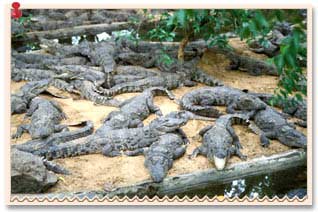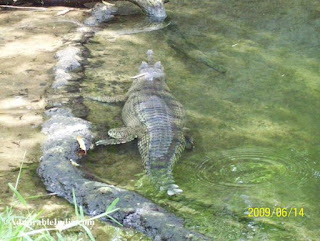http://www.chennai.org.uk/excursions/crocodile-bank.html
 The Crocodile Bank is sited at around 44 km away from the capital city of Tamil Nadu, near Mahabalipuram. It extends over an area of about 3.2 hectares, comprising a wide range of Indian and African crocodiles, alligators and other reptiles including turtles and snakes. Here, the crocodiles are kept in their natural habitat. Founded by Romulus Whitaker, the German Biologist in 1976, to conserve the species of crocodiles and alligators which are endangered, it is provided with lush tropical vegetation for giving ample shade to these reptiles. At the time of its establishment, the total population of the crocodiles was only 30. Presently, it has 14 varieties of crocodiles, 12 species of turtles and 5 types of snakes, with total number of 2,400 reptiles in the Crocodile Bank.
The Crocodile Bank is sited at around 44 km away from the capital city of Tamil Nadu, near Mahabalipuram. It extends over an area of about 3.2 hectares, comprising a wide range of Indian and African crocodiles, alligators and other reptiles including turtles and snakes. Here, the crocodiles are kept in their natural habitat. Founded by Romulus Whitaker, the German Biologist in 1976, to conserve the species of crocodiles and alligators which are endangered, it is provided with lush tropical vegetation for giving ample shade to these reptiles. At the time of its establishment, the total population of the crocodiles was only 30. Presently, it has 14 varieties of crocodiles, 12 species of turtles and 5 types of snakes, with total number of 2,400 reptiles in the Crocodile Bank.
Indian varieties of crocodiles namely the Mugger – Crocodylus Paluster, which is 3.6 meter long and is commonly found, the Ghariyal – Gavialis Gangeticus, which is 4-5 meter long and has the longest jaw and the saltwater Crocodile – Crocodylus Porosus, the largest of reptiles contribute signifficantly to the total population in the bank. It also includes Morlet's crocodile from Mexico, American Alligator from Africa, Dwarf crocodile from Africa and the Siamese crocodile. The bank is one of the most popular tourist spots where visitors come in a large number every year to watch different reptiles in their natural surroundings and since all the creatures are kept in open pools, they can be easily observed from a safe proximity.
However, the main spot of attraction is the Crocodile Conservation Centre, which is the largest breeding locale of crocodiles in India and since its origination, thousands of crocodiles have bred here. This bank also houses a Snake Farm, where anti-venom is produced. The Irula Snake Catchers' Industrial Cooperative Society has a show of venom extraction on daily basis which is a source great enthrallment for the visitors. The process of venom extraction was started on 16th December 1982 and now, the place has become the largest venom-producing centre in India with an annual turnover of US $ 15,000. The place is also thinking to conserve green anacondas under an international exchange programme. So for this, four adult green anacondas of an average length of 4 metres are brought from the Danish Crocodile Exhibition held in Denmark in exchange of marsh crocodiles, the gharials and the African slender snouted crocodiles.
Besides all this, the bank also conducts research on the biology of crocodiles, alligators, turtles and observes lizards. Honoured with the Ford Conservation and Environmental Grant 2001 for the project 'Integrated Environment Education', a multi-lingual programme on the preservation of reptiles to create an environmental awareness has further made it a not-to-be-missed attraction among the tourists. The authorities are also planning to set up a second bank on the western coast of India, in Goa, along with planning to get four new varieties of crocodiles, including black caimans, smooth-fronted caimans, Cuban crocodiles and broad-snouted caimans.
Crocodile Bank
| Location: | Near Mahabalipuram |
| Distance: | 40 km from Chennai |
| Founded In: | 1976 |
| Founded By: | Romulus Whitaker |
| Area: | 3.2 hectares |
| Main Attractions: | Various Species of Crocodiles, Alligators and other reptiles |
 The Crocodile Bank is sited at around 44 km away from the capital city of Tamil Nadu, near Mahabalipuram. It extends over an area of about 3.2 hectares, comprising a wide range of Indian and African crocodiles, alligators and other reptiles including turtles and snakes. Here, the crocodiles are kept in their natural habitat. Founded by Romulus Whitaker, the German Biologist in 1976, to conserve the species of crocodiles and alligators which are endangered, it is provided with lush tropical vegetation for giving ample shade to these reptiles. At the time of its establishment, the total population of the crocodiles was only 30. Presently, it has 14 varieties of crocodiles, 12 species of turtles and 5 types of snakes, with total number of 2,400 reptiles in the Crocodile Bank.
The Crocodile Bank is sited at around 44 km away from the capital city of Tamil Nadu, near Mahabalipuram. It extends over an area of about 3.2 hectares, comprising a wide range of Indian and African crocodiles, alligators and other reptiles including turtles and snakes. Here, the crocodiles are kept in their natural habitat. Founded by Romulus Whitaker, the German Biologist in 1976, to conserve the species of crocodiles and alligators which are endangered, it is provided with lush tropical vegetation for giving ample shade to these reptiles. At the time of its establishment, the total population of the crocodiles was only 30. Presently, it has 14 varieties of crocodiles, 12 species of turtles and 5 types of snakes, with total number of 2,400 reptiles in the Crocodile Bank.Indian varieties of crocodiles namely the Mugger – Crocodylus Paluster, which is 3.6 meter long and is commonly found, the Ghariyal – Gavialis Gangeticus, which is 4-5 meter long and has the longest jaw and the saltwater Crocodile – Crocodylus Porosus, the largest of reptiles contribute signifficantly to the total population in the bank. It also includes Morlet's crocodile from Mexico, American Alligator from Africa, Dwarf crocodile from Africa and the Siamese crocodile. The bank is one of the most popular tourist spots where visitors come in a large number every year to watch different reptiles in their natural surroundings and since all the creatures are kept in open pools, they can be easily observed from a safe proximity.
However, the main spot of attraction is the Crocodile Conservation Centre, which is the largest breeding locale of crocodiles in India and since its origination, thousands of crocodiles have bred here. This bank also houses a Snake Farm, where anti-venom is produced. The Irula Snake Catchers' Industrial Cooperative Society has a show of venom extraction on daily basis which is a source great enthrallment for the visitors. The process of venom extraction was started on 16th December 1982 and now, the place has become the largest venom-producing centre in India with an annual turnover of US $ 15,000. The place is also thinking to conserve green anacondas under an international exchange programme. So for this, four adult green anacondas of an average length of 4 metres are brought from the Danish Crocodile Exhibition held in Denmark in exchange of marsh crocodiles, the gharials and the African slender snouted crocodiles.
Besides all this, the bank also conducts research on the biology of crocodiles, alligators, turtles and observes lizards. Honoured with the Ford Conservation and Environmental Grant 2001 for the project 'Integrated Environment Education', a multi-lingual programme on the preservation of reptiles to create an environmental awareness has further made it a not-to-be-missed attraction among the tourists. The authorities are also planning to set up a second bank on the western coast of India, in Goa, along with planning to get four new varieties of crocodiles, including black caimans, smooth-fronted caimans, Cuban crocodiles and broad-snouted caimans.










No comments:
Post a Comment